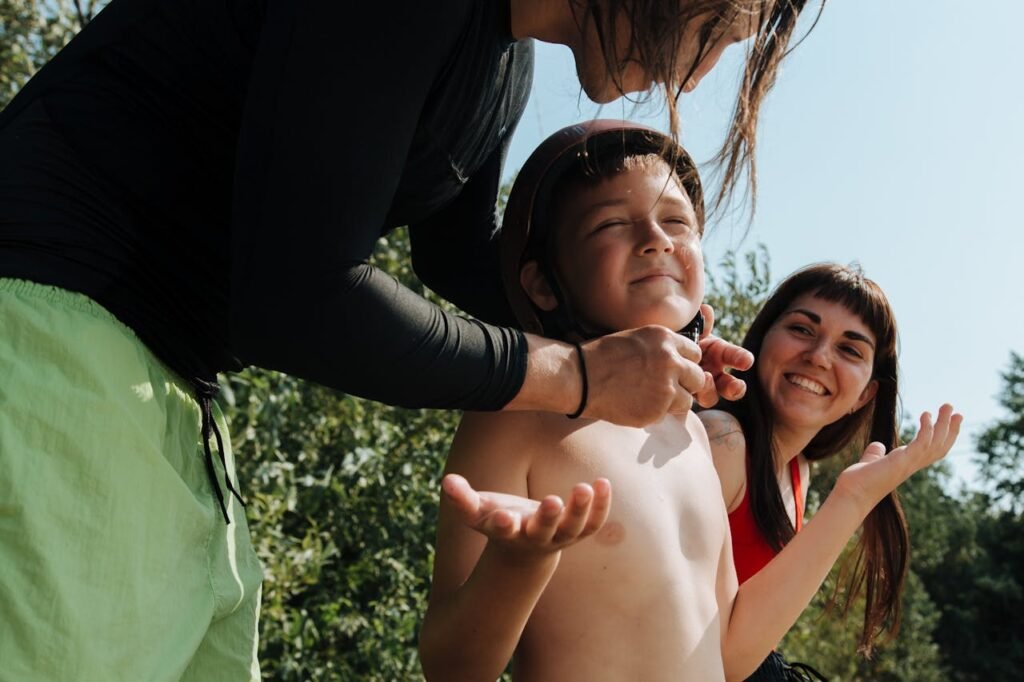Parents often hear about the dangers of sun exposure, but too many still overlook just how vital daily sun protection is—no matter the season. As a pediatrician, I cannot stress enough how early and consistent sun safety habits protect not only your child’s skin but their long-term health. This blog will walk you through the most effective, pediatrician-backed sun safety strategies for children of all ages, whether they’re playing in the backyard or walking to school in winter.
If your goal is to keep your child healthy, start with what they’re exposed to every single day: the sun. Let’s unpack everything you need to know to make sun protection part of your family’s lifestyle.
Why Sun Safety Should Be Non-Negotiable
You may already use sunscreen on beach days—but that’s not enough. Pediatricians are seeing more skin-related issues in children who aren’t adequately protected from UV radiation. It’s not just about sunburn; repeated sun exposure, even when mild, can:
-
Cause premature skin aging
-
Damage eyes and vision
-
Lead to suppressed immune responses
-
Significantly increase the risk of skin cancer later in life
That’s why pediatricians recommend sun safety practices all year—not just during the summer.
UV Rays Don’t Take a Break: Why Year-Round Protection Matters
A common myth is that children only need protection during summer vacations. In truth, UV rays are harmful regardless of temperature. In fact, snow can reflect up to 80% of UV radiation—posing a risk even in colder climates.
As pediatricians, we see many cases of UV-related eye irritation and recurring skin sensitivity in children who only use protection seasonally. Consistent sun protection should be as routine as brushing teeth or wearing a seatbelt.

Start Early: When Should Sun Protection Begin?
According to pediatric guidelines, sun protection should begin in infancy. Babies under six months should be kept out of direct sunlight entirely, and once older, a combination of sunscreen, clothing, and shade should become second nature.
Integrating these habits early sets a healthy pattern, much like how parents help children regulate screen time or manage behavioral challenges such as ADHD. If your child also struggles with focus or hyperactivity in outdoor environments, read more on how pediatricians can help at How Pediatricians Help Diagnose and Manage ADHD in Children.
Pediatrician-Recommended Sunscreen Guidelines
1. Broad Spectrum is a Must
Choose a sunscreen that protects against both UVA and UVB rays. Pediatricians consistently recommend SPF 30 or higher for adequate daily coverage.
2. Stick to Mineral-Based Formulas for Young Skin
Zinc oxide and titanium dioxide are preferred for infants and toddlers due to their gentler formulation.
3. Apply 15 Minutes Before Going Outside
Give the sunscreen time to absorb. Pediatricians recommend applying it to all exposed skin areas—especially the ears, neck, and tops of feet.
4. Reapply Every 2 Hours—or Sooner If Swimming
Even water-resistant formulas wear off. Reapply after excessive sweating or time in the water.
Dress for Protection, Not Just Style
Pediatricians often see children arriving at clinics with mild heat rashes or sunburns that could’ve been avoided with appropriate clothing. The right outfit can act as a physical barrier between your child’s sensitive skin and UV rays.
Choose:
-
Long-sleeved, breathable cotton shirts
-
Wide-brimmed hats
-
UV-protective sunglasses
-
Lightweight pants or long shorts
Clothing labelled UPF 50+ is especially effective and pediatrician-approved for active children.
Understand the UV Index Before Stepping Out
Checking the UV Index should be part of your family’s daily routine—just like checking the weather. A UV Index of 3 or higher means protection is necessary. On high-risk days (UV Index of 6+), pediatricians recommend staying indoors during peak hours (10 a.m.–4 p.m.) or scheduling shaded, indoor play.
Sun Safety at School and Camp
School environments often lack adequate shaded outdoor spaces, and many kids forget to reapply sunscreen on their own. As pediatricians, we encourage parents to:
-
Send children to school with a roll-on sunscreen stick
-
Educate kids on how and when to reapply
-
Talk to teachers and camp counselors about your sun safety expectations
If your child suffers from frequent ear infections worsened by heat or prolonged sun exposure, make sure their ears are protected. Learn more about this connection at Ear Infections in Kids: Symptoms Parents Shouldn’t Ignore.
Hydration Matters: Avoid Heat-Related Illness
Prolonged sun exposure doesn’t just pose a risk to your child’s skin—it can lead to dehydration and heat exhaustion. Pediatricians advise the following:
-
Offer water every 20–30 minutes during active play
-
Avoid sugary drinks in hot weather—they dehydrate faster
-
Watch for signs of overheating: flushed cheeks, rapid breathing, or confusion
Keep electrolyte-rich fluids on hand during high-heat days and be alert to changes in behavior.
What Pediatricians Want You to Know About Infant Sun Safety
Infants under six months should not wear sunscreen. Their skin absorbs chemicals more easily, which may lead to irritation or long-term issues. Pediatricians instead recommend:
-
Keeping infants in shaded areas only
-
Using lightweight blankets or stroller covers
-
Dressing them in full-coverage clothing and hats
If sun exposure is unavoidable, use mineral-based sunscreen only on small exposed areas like hands or feet—but only as a last resort.
Common Mistakes Parents Make (and How to Avoid Them)
Despite good intentions, pediatricians often observe these preventable mistakes:
1. Using expired sunscreen
Old sunscreen can lose potency and increase the risk of burns. Check expiry dates every season.
2. Forgetting cloudy days still require protection
Up to 80% of UV rays penetrate clouds. Pediatricians advise sun protection regardless of weather.
3. Only applying sunscreen once
One-time application isn’t enough. Reapplication is key, especially for active kids.
4. Skipping lips and scalp
Use lip balms with SPF and don’t forget to protect the scalp with hats or hair-part sunscreen sticks.
Creating a Pediatrician-Backed Sun Safety Routine

Sun protection should become an automatic part of your child’s day. A sample routine could look like this:
-
Morning: Apply sunscreen after brushing teeth
-
Before school: Put on a sun hat and sunglasses
-
Midday (if home): Reapply sunscreen, take indoor break
-
After-school play: Hydrate, reapply sunscreen, use shaded areas
-
Evening: Bathe to remove sunscreen residue, moisturize skin
This structure creates healthy, sun-smart habits that carry into adulthood.
When to See a Pediatrician for Sun-Related Issues
Despite precautions, sun exposure can sometimes cause harm. Pediatricians recommend visiting your provider if you notice:
-
Persistent redness or peeling beyond 48 hours
-
Blistering, especially on infants or toddlers
-
Sudden swelling of the face or eyes after sun exposure
-
Changes in moles or skin patches over time
It’s crucial to monitor how your child’s skin reacts to products and sun over time.
Are Tans Safe for Kids? Pediatricians Say No
A tan is a sign of skin damage—not health. Pediatricians are clear: there’s no such thing as a safe tan. Tanning in childhood, whether deliberate or incidental, significantly increases the lifetime risk of melanoma. Encourage your child to embrace their natural skin tone and reinforce that sun protection isn’t about vanity—it’s about health.
What About Vitamin D? Balancing Sun and Supplements
Some parents worry that strict sun protection might limit vitamin D synthesis. While the sun does play a role, pediatricians recommend getting vitamin D from food and supplements, not prolonged exposure. The American Academy of Pediatrics recommends 400 IU of vitamin D daily for children under one year, and 600 IU for older children.
This allows you to focus on sun safety without compromising bone health.
Sun safety isn’t a seasonal concern—it’s a year-round, pediatrician-backed priority for every family. By turning daily habits into protective routines, you’ll be safeguarding your child’s health in a way that impacts their long-term wellbeing.
From sunscreen to sun hats, from hydration to shade, every measure counts. And as pediatricians, we are here to help guide you in building that foundation.
